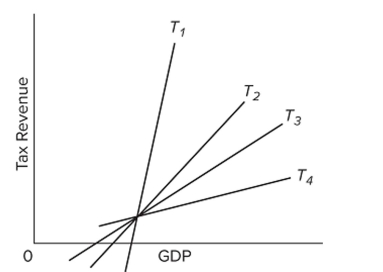A) expansionary fiscal policy.
B) a major recession.
C) contractionary fiscal policy.
D) demand-pull inflation.
Correct Answer

verified
Correct Answer
verified
Multiple Choice
A tax reduction of a specific amount will be more expansionary the
A) smaller is the economy's MPC.
B) larger is the economy's MPC.
C) smaller is the economy's multiplier.
D) less is the economy's built-in stability.
Correct Answer

verified
Correct Answer
verified
Multiple Choice
The American Recovery and Reinvestment Act of 2009 included mostly
A) increases in taxes and in government spending.
B) decreases in taxes and in government spending.
C) increases in government spending and decreases in taxes.
D) decreases in government spending and increases in taxes.
Correct Answer

verified
Correct Answer
verified
Multiple Choice
Which of the following best describes the idea of a political business cycle?
A) Politicians are more willing to cut taxes and increase government spending than they are to do the reverse.
B) Fiscal policy will result in alternating budget deficits and surpluses.
C) Politicians will use fiscal policy to cause output, real incomes, and employment to be rising prior to elections.
D) Despite good intentions, various timing lags will cause fiscal policy to reinforce the business cycle.
Correct Answer

verified
Correct Answer
verified
Multiple Choice
Proponents of the notion of a "political business cycle" suggest that
A) the standardized budget is a better indicator of the state of the economy than the actual budget, for political reasons.
B) cyclical swings in the economy are produced by the inherent political instability found in capitalist economies.
C) a possible cause of economic fluctuations is the use of fiscal policy by policymakers for political purposes and goals.
D) there is constant political trading among policymakers that tends to make the economic policies of state and local governments procyclical.
Correct Answer

verified
Correct Answer
verified
Multiple Choice
A) a tax reduction
B) a tax reduction accompanied by an even larger reduction in government spending
C) a tax increase accompanied by an even larger increase in government spending
D) an increase in government spending
Correct Answer

verified
Correct Answer
verified
Multiple Choice
The two reasons why bankruptcy is a false concern about the public debt are
A) government spending and taxation.
B) refinancing and taxation.
C) investment and refinancing.
D) saving and investment.
Correct Answer

verified
Correct Answer
verified
Multiple Choice
In 2018, the U.S. federal debt held by the public was
A) held largely by foreign governments.
B) about four times as large as the GDP.
C) about twice as large as the GDP.
D) about 76 percent of the size of the GDP.
Correct Answer

verified
Correct Answer
verified
Multiple Choice
One important reason why the United States government is not likely to go bankrupt even with a large public debt is that it has
A) the power to print money to finance the debt.
B) a strong military to protect it from creditors.
C) the capacity to pay off its outstanding debt with gold.
D) the ability to decrease interest rates and increase investment spending.
Correct Answer

verified
Correct Answer
verified
Multiple Choice
 Refer to the diagram. Which tax system has the most built-in stability?
Refer to the diagram. Which tax system has the most built-in stability?
A)
B)
C)
D)
Correct Answer

verified
Correct Answer
verified
Multiple Choice
If people expected that a fiscal policy in the form of a tax cut was temporary, then this policy's effect on the economy would tend to be
A) stronger.
B) weaker.
C) the exact opposite of what was intended.
D) as the multiplier effect would predict.
Correct Answer

verified
Correct Answer
verified
True/False
Tax revenues automatically increase during economic expansions and decrease during recessions.
Correct Answer

verified
Correct Answer
verified
Multiple Choice
The accompanying table gives budget information for a hypothetical economy. Assume that all budget surpluses are used to pay down the public debt. A budget surplus occurred in year
A) 2.
B) 3.
C) 4.
D) 6.
Correct Answer

verified
Correct Answer
verified
Multiple Choice
The accompanying table gives budget information for a hypothetical economy. Assume that all budget surpluses are used to pay down the public debt. The public debt declined in year
A) 6.
B) 5.
C) 4.
D) 3.
Correct Answer

verified
Correct Answer
verified
Multiple Choice
If the crowding-out effect is at its maximum strength, it follows that an increase in government spending will
A) cause aggregate demand and GDP to increase.
B) cause aggregate demand and GDP to decrease.
C) not affect aggregate demand and GDP.
D) not cause the budget deficit to increase.
Correct Answer

verified
Correct Answer
verified
Multiple Choice
Through the start of 2009, Social Security revenues exceeded payouts, and the excess inflow was used to buy
A) public lands.
B) gold certificates.
C) foreign securities.
D) Treasury securities.
Correct Answer

verified
Correct Answer
verified
Multiple Choice
A) cyclically adjusted budget surplus only.
B) cyclically adjusted budget deficit only.
C) cyclically adjusted budget surplus and an actual budget surplus.
D) cyclically adjusted deficit and an actual budget deficit.
Correct Answer

verified
Correct Answer
verified
True/False
Permanent tax reductions are more likely to be expansionary than temporary tax reductions.
Correct Answer

verified
Correct Answer
verified
Multiple Choice
Which of the following historically has not been a significant contributor to the U.S. public debt?
A) war financing
B) tax cuts and expenditure increases during the Great Recession
C) recessions
D) demand-pull inflation
Correct Answer

verified
Correct Answer
verified
Multiple Choice
A) reduce government expenditures and taxes by equal-size amounts.
B) reduce government expenditures or increase taxes.
C) increase government expenditures or reduce taxes.
D) reduce unemployment compensation benefits.
Correct Answer

verified
Correct Answer
verified
Showing 81 - 100 of 401
Related Exams